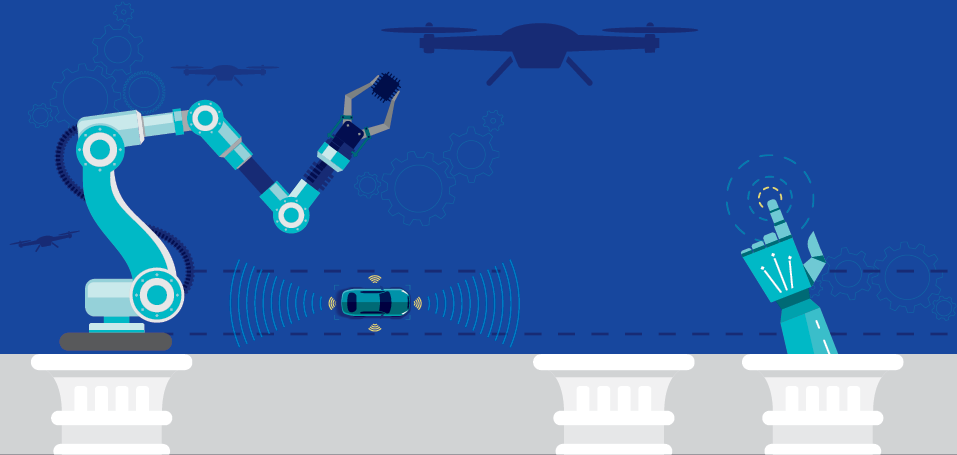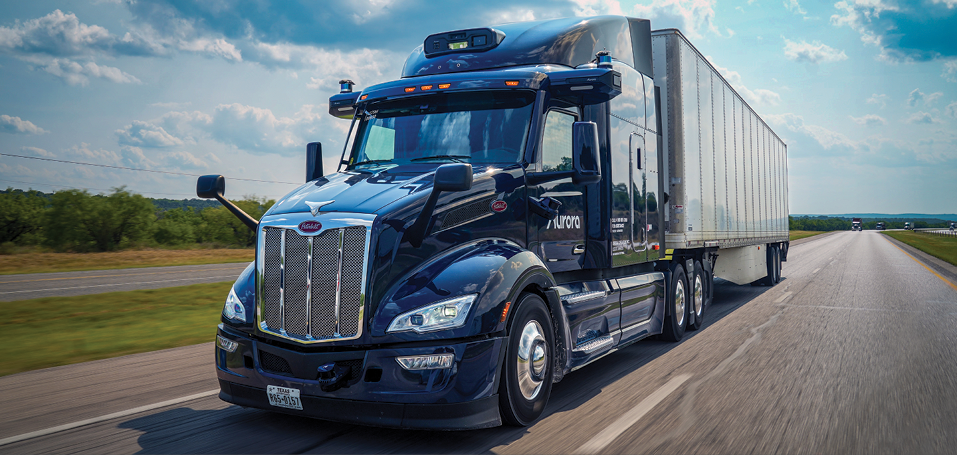A Hidden Engine in America’s Tech Industry
How Government-funded Research Transforms Groundbreaking Experiments into Billion-dollar Industries
SHERI HALL
In the robotics labs at Carnegie Mellon University’s School of Computer Science, researchers are building robots that learn through trial and error, achieve human-level dexterity, and navigate the world independently. These breakthroughs aren’t just academic accomplishments; they often become building blocks for the U.S economy. Over the past 20 years, research from CMU’s School of Computer Science has launched dozens of startups that anchor Pittsburgh’s tech sector and shape industries far beyond it.
Jonathan Hurst (ENG 2001, SCS 2004, 2008), Chief Robot Officer of Agility Robotics
These success stories trace back to an often overlooked catalyst: basic research made possible by sustained government funding. Without it, many of today’s most advanced technologies — autonomous vehicles, smart factories, surgical robots — might only have been big ideas.
“You cannot do this kind of blue-sky exploration at a company — the only way to do it is publicly funded research,” said Jonathan Hurst (ENG 2001, SCS 2004, 2008), who received his Ph.D. in robotics from CMU and is now the chief robot officer at Agility Robotics, an Oregon company that created the first commercially available humanoid robot.
Hurst credits the U.S. lead in the world in so many fields to the support researchers receive from universities and federal grants. “It takes an unbelievable investment to go from a big idea to a product that ultimately launches a new industry and builds the economy,” he said.
Agility Robotics is just one of dozens of companies dreamt up, developed and funded through CMU’s Robotics Institute (RI).
Sebastian Scherer, Associate Research Professor in the RI
RI Associate Professor Sebastian Scherer, whose research focuses on building “resilient” robots that can interact with and adapt to their surroundings, has personally been a part of two startups. Near Earth Autonomy builds autonomous aircraft for the U.S. military. And Field AI builds and sells data-collecting robots, which are deployed in eight different industries to monitor critical equipment at facilities in the oil and gas industry; collect data on construction sites to help general contractors stay on top of progress and avoid critical and costly mistakes; and provide security by autonomously patrolling the exterior of a building or jobsite location. In addition, Scherer’s AirLab, where researchers explore autonomous flight, has launched dozens of other concepts into successful businesses.
“The investment — by both Carnegie Mellon and in federal research dollars — has a huge impact,” Scherer said. “It allows you to try out some innovative ideas at a low cost with really motivated graduate students. Some of those ideas bloom. And if you marry them with an interesting business case, you can create a lot of value.”
“The important thing to remember is that venture capitalists would not invest in these initial stages,” he continued. “They need to see a product that is roughly working. Getting to that point only comes from government funding.”
Sanjiv Singh (SCS 1991, 1995), CEO and Co-founder of Near Earth Autonomy
Sankalp Arora (SCS 2018), CEO and Founder of Gather AI
Basic Research Inspires Inventors
But it’s not just about developing new technology and starting new companies. A major benefit of this type of research is developing people — the next generation of inventors — who can turn a concept into a marketable product.
“This type of government funding — from NASA, the Department of Defense, the National Science Foundation, the U.S. Department of Agriculture — it’s instrumental in developing people,” said Sanjiv Singh (SCS 1991, 1995), CEO and co-founder of Near Earth Autonomy, a company that creates autonomy systems for aircraft. “It’s easy to focus on the technology, but developing people is huge. If your product doesn’t work out, you still have a whole group of people who have learned how to formulate problems, do the work and deliver on solutions. And they go out into the world and do more of this type of work.”
A perfect example is Gather AI, another startup who found its roots in Scherer’s lab. Gather AI builds software systems that enable autonomous data collection to help warehouses run more efficiently. It’s staffed with dozens of graduates from CMU’s Robotics Institute.
Drones powered by Gather AI’s proprietary software can navigate warehouse environments, capturing images of inventory to identify SKU numbers, improperly stacked merchandise, damaged goods and more, explained CEO and founder Sankalp Arora (SCS 2018), who earned his Ph.D. in robotics at the RI.
“A warehouse may have 500,000 pairs of jeans, and the company has to find the exact right pair to ship to you,” Arora explained. “We are making that a lot easier.” Demand for these systems is growing as online shopping continues to expand globally.
Arora can draw a direct line from his research as a CMU doctoral student to Gather AI. “The founding scientists were actually my lab mates,” he said. “We received federal grants for projects during which we developed initial ideas of some of the techniques our company is using. And the amplifying effect is important. Because work at Carnegie Mellon draws the attention of the larger community, and then the investors come.” Read more on Arora and Gather AI.
CMU Faculty Drive Economic Growth
While many SCS students start successful businesses after graduating, faculty members who remain play a critical role in developing concepts and launching companies.
Howie Choset, the Kavčić-Moura Professor of Computer Science, has personally been involved in six startups based on his students’ research at CMU. “My group is very good at building snake robots,” said Choset. “We’ve found a lot of commercial applications for the core technology that enables them to move through tight spaces.”
Howie Choset, Kavčić-Moura Professor of Computer Science in the RI
Among his companies is Medrobotics, which built snake-like robots for minimally invasive surgery. “Our robots operated on 1,500 people people,” Choset said. “Beyond seeing my students graduate, watching my robot perform its first heart surgery was one of the proudest professional moments of my life.”
Along with some of his graduate students, Choset also founded Hebi Robotics, which sells modular robotic solutions to companies across the globe. Choset was motivated to start this company so he could continue working with his students after they graduated. “What I was trying to do was keep the band together,” he said. “My amazing students have this pesky habit —they graduate. So I found a way to keep working together. Hebi helps me with my research and teaching to this day!”
With his students, Choset recently co-founded Pipe Force AI, which leverages the confined-space technology developed for snake robots to create an interactive system to inspect, map and diagnose problems with underground infrastructure. Choset serves as the CEO of Pipe Force AI. He also serves as the president of Bito Robots, a factory logistics company also co-founded with his students.
His research has been funded by the NSF, the National Institutes of Health, Defense Advanced Research Projects Agency (DARPA), Department of Energy and Office of Naval Research.
“We have to acknowledge that basic research is what’s going to change the economy — it’s the foundation of all of these companies,” he said. “However, the public has to expect that any one project will not have a huge impact, but collectively they do. Not investing in basic research guarantees we will never change the economy.”
On a separate note, Choset says CMU is uniquely positioned to cultivate new businesses.
“CMU is a key player in basic research,” he said. “We do multidisciplinary work like no other place. CMU is a great place to be an entrepreneur.”
New Technologies Create New Markets
It’s a sentiment shared by hundreds of faculty members and graduates from the School of Computer Science: CMU is a great breeding ground for new companies.
Hurst, who co-founded Agility Robotics, explained how his business — and, in fact, the entire industry of humanoid robots — is only possible because of the research conducted at CMU.
As a doctoral student, Hurst studied locomotion, or how to make robots move like humans, thanks to a fellowship from the National Science Foundation (NSF).
After seven years at Carnegie Mellon, Hurst knew he wanted to start a company with the discoveries he had made. But he also knew the technology wasn’t ready, so he took a robotics professorship at Oregon State University, where he helped found a new robotics institute.
His work there was paid for by DARPA, part of the U.S. Department of Defense that focuses on developing breakthrough technologies for national security. Grants from the NSF and DARPA funded Hurst’s idea to the tune of more than $10 million until it was ready for commercialization. Now, Agility Robotics is the first company placing humanoid robots in stores, warehouses and manufacturing facilities.
Hurst described how robots began with simple automation — think of a robotic arm in a factory — and then advanced to autonomous robots that could function independently, but only in controlled environments.
“The era we’re entering now is creating human-centered robots, which means the robots can coexist in a space designed for people,” he explained. “Our market is moving bins and totes in warehouses, but that’s the tip of the iceberg. We looked at hundreds of use cases, and this just happens to be the one that justifies the purchase of a humanoid robot now.”
Agility’s robot — named Digit — currently works in e-commerce warehouses, where demand for labor regularly outpaces the available workforce. Digit is able to load and unload pallets, move boxes and bins, and manage recycling.
But as costs decrease, applications for humanoid robots will increase, Hurst said. Within 10 years, Goldman Sachs predicts a $35 billion market for humanoid robots. Prominent investor Vinod Khosla predicts it will be bigger than the automotive industry within 20 years. Hurst thinks that is a realistic comparison.
“Humanoids are going to change how economies work,” he said. “This wouldn’t be possible without the past 20 to 30 years of well-funded research to create this technology.” ■
Genesis AI Takes on Physical Labor with $105M Launch
Genesis AI, a new robotics company with roots at Carnegie Mellon and other leading institutions, has emerged from stealth with $105 million in funding and a bold mission: to automate physical labor at scale using a universal robotics foundation model.
At present, less that 5% of physical labor is automated. Today’s robotics systems are often expensive and inflexible; Genesis AI aims to change that with a data-centric, full-stack approach to “physical AI” — the intelligence that enables machines to interact with the real world.
The company is developing a scalable data engine that combines high-fidelity simulation, multimodal generative modeling and real-world robot data. This hybrid synthetic-real system is designed to generate the vast, diverse training data needed to power Robotics Foundation Models (RFMs) — analogous to the foundation models that transformed digital AI.
"Digital AI has advanced rapidly, but physical AI has lagged behind," said Zhou Xian (SCS 2024), Genesis founder. “We’re building on digital AI’s foundations to bring human-level intelligence to machines in the physical world.”
The company’s founding team includes experts from Mistral AI, Nvidia, Google, CMU, MIT, Stanford, Columbia and University of Maryland, spanning physics simulation, robotics and large-scale AI. Genesis plans to open-source key components of its system to accelerate development across the field.
As global labor shortages intensify, Genesis sees its platform as critical infrastructure for the future of work — and the dawn of scalable, general-purpose robotics. ■









